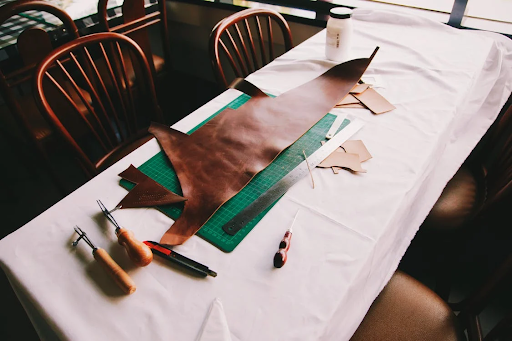Vegan vs. Animal Leather
Have you ever wondered how your leather products were made? You may have assumed that only animal skin is used, and that it undergoes the tanning process in a factory. This is true, as most leathers are made from dead cow skin. What you may have not known is the environmental impacts of not only using animal skin, but also of the chrome tanning process.There are also vegan leathers that are made from things you may have never guessed!
Animal Leather and Chromium Tanning
So, you may think, what is wrong with using leather if the animal has already passed? Well, the leather industry is considered a by-product of the meat industry. This is because, when buying a product from the leather industry, it financially supports the same slaughterhouses who kill animals for the food industry.
Image Source: http://yekta-tejarat.com/?p=118
Not only are there industries that slaughter animals for the sole purpose of using their skin for leather, but the chrome tanning process can be very harmful for the environment, the communities near the factories, and the workers who are involved in the tanning process. After receiving the skin, the workers soak it in chromium sulfate chemical solutions. Carcinogenic chemicals such as chromium, formaldehyde, and arsenic are used to dye and smooth out the leather, but are rarely disposed of properly. These toxins harm both the workers and nearby communities, giving them cancer and other health conditions.
Not only do the chemicals used when tanning endanger the environment, but so does the leather itself. While companies are creating leather products, lots of the material is solid organic wastes, like salts, hair, splittings, chrome shavings, and flesh. Improper disposal of this material harms the soil and groundwater, releasing dangerous greenhouse gasses into the atmosphere.
Leather and Tanning Alternatives
Luckily, there are other options out there. Vegan leathers are often used to replicate animal leather, but in an environmentally friendly way. Many vegan leathers are sourced from fruits, such as apples, coconuts, and grapes, as an alternative to animal skin. They also use a different tanning process known as vegetable tanning, where factories use plant extracts to tan the leather, and only use non-toxic, natural dyes. These techniques result in minimal pollution and better quality products, which last longer than chrome tanned animal leather.
The vegetable tanning process can be used on both vegan leather and animal skin leather. It requires lots of practice to perfect this technique, and was originally used in Ancient Egypt, where they would make clothing and shelter with animal skin.
Unlike the chrome tanning process, where the leather is tanned with carcinogenic chromium, vegetable tanned leather is soaked in salt water, or just regular water, over the course of a few months. After the leather is soaked, it then undergoes the pickling and bating process, which makes the leather softer by breaking down the proteins and prepares them for tanning. Then, lastly, the leather is tanned with oak bark, source bark, quebracho, tara pods, olive leaves, rhubarb roots or mimosa. Whereas chrome tanning takes as low as two weeks, however, vegetable tanning can take up to 70 days to complete. Because of this, only a very small percentage (as low as 10%) use the vegetable tanning process.
Brands Using Leather
Having so many different leather alternatives can encourage brands to try new, ethical ways of producing leather. As the years pass and more information is learned, many brands are switching to vegan leather: Louis Vuttion uses corn, Hermes uses mushrooms, and Chanel uses pineapple. In the future, I hope more brands incorporate more of these alternatives for a more sustainable future!
Written by Kara Haas
Kara is a high school student who is an aspiring writer. She is hoping to study journalism in college to write about the fashion industry in the future. As well as having a passion for writing, Kara also loves to study fashion and try new, different looks out of her comfort zone. In her free time she loves baking, trying new makeup looks, and watching cartoons.


